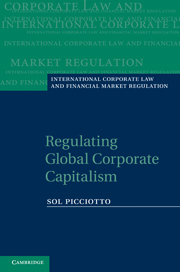Book contents
- Frontmatter
- Contents
- Preface
- Acknowledgements
- Table of cases
- Abbreviations and acronyms
- 1 Transformations of global governance
- 2 Liberal internationalism: strengths and limits
- 3 From interdependence to fragmentation
- 4 Corporations and competition
- 5 Corporate rights and responsibilities
- 6 International taxation
- 7 Regulation of international finance
- 8 The WTO as a node of global governance
- 9 Intellectual property rights
- 10 Law and legitimacy in networked governance
- Bibliography
- Index
4 - Corporations and competition
Published online by Cambridge University Press: 05 June 2012
- Frontmatter
- Contents
- Preface
- Acknowledgements
- Table of cases
- Abbreviations and acronyms
- 1 Transformations of global governance
- 2 Liberal internationalism: strengths and limits
- 3 From interdependence to fragmentation
- 4 Corporations and competition
- 5 Corporate rights and responsibilities
- 6 International taxation
- 7 Regulation of international finance
- 8 The WTO as a node of global governance
- 9 Intellectual property rights
- 10 Law and legitimacy in networked governance
- Bibliography
- Index
Summary
The corporation or company is the main form developed under industrial capitalism for carrying on business, and hence it is a key social institution. It provides an institutional framework which enables business to be organized on a large scale, and to coordinate a variety of activities, even across the world. Institutionalized firms can coordinate and plan activities which are both more extensive and potentially long-term than individual or family businesses. Hence, if the basic business unit is referred to as the firm, incorporation allows it to take a form which may be described as the impersonal firm.
Due to these features, the corporation has enabled the radical transformation of capitalism, from laissez-faire to regulated corporate capitalism. The extent of this transformation is often ignored both by capitalism's supporters and its critics. Its impact has been well summarized as follows:
Capitalism has developed as a system of a limited number of giant corporations working at vast scales to bureaucratic plans administered by professional managers. Accumulation is pursued but in a restrained form compatible with oligopolistic coexistence. In particular, price competition is irrelevant to pricing decisions in the influential sectors of the economy and has been more or less displaced as a form of competition by cost-cutting (whilst holding price constant) and by the sales effort. The smaller firms and consumers in the residual areas of the economy must take the production decisions of the large corporate price makers as the crucially determining boundaries of the relatively unimportant decisions they are left to make. […]
- Type
- Chapter
- Information
- Regulating Global Corporate Capitalism , pp. 108 - 154Publisher: Cambridge University PressPrint publication year: 2011



